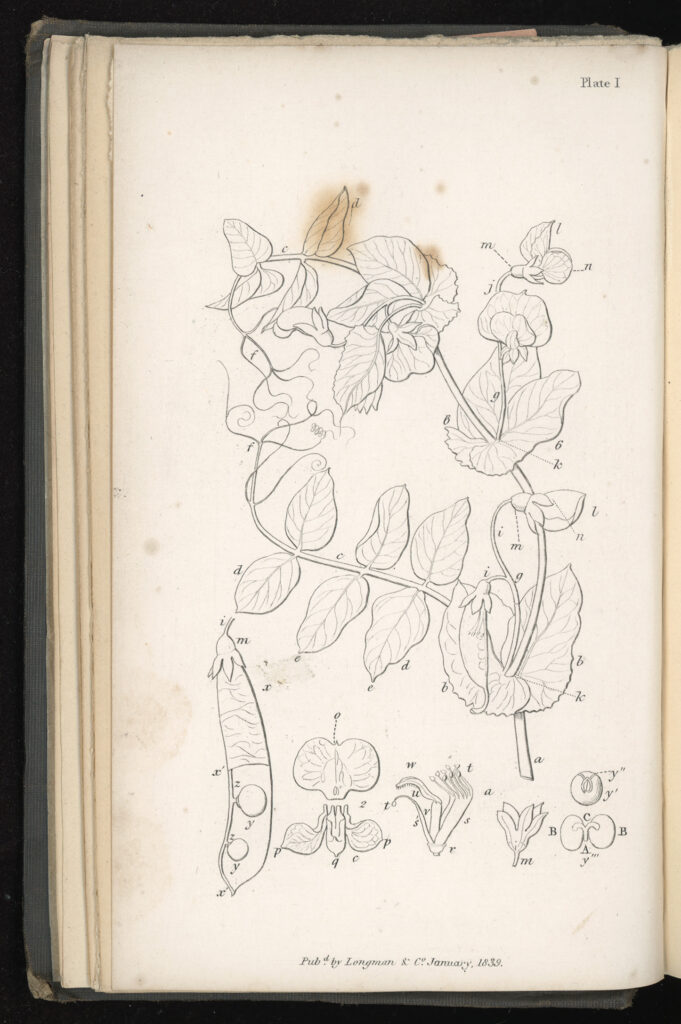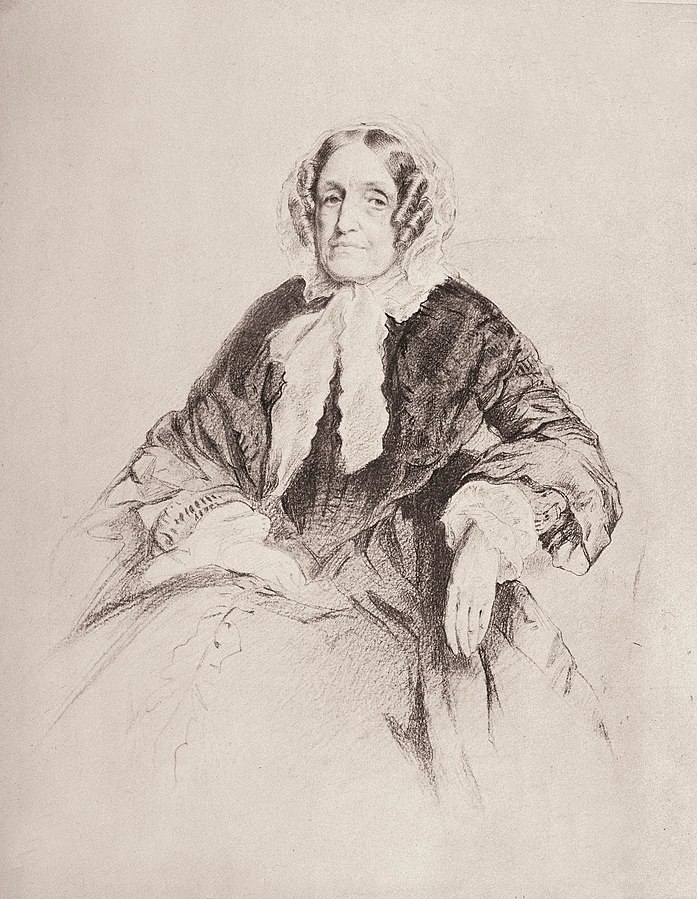Jane Marcet was an unusual woman. She believed that girls as well as boys should be educated in science and economics and that scientific knowledge should not be hidden behind a requirement for proficiency in Latin and Greek. She loved to learn and was keen to share her enjoyment of learning with others. When she was unable to find books that satisfied her own curiosity, she wrote them herself.
Jane Marcet the hostess
Born in 1769, Jane was educated alongside her brothers under the guidance of her father Francis Haldimand, a rich Swiss merchant established in London. The household was a lively one, often gathering groups of friends and intellectuals. After her mother’s death, Jane took on the role of hostess and relished the stimulating and intelligent company of her father’s friends. In 1799 Jane married medical doctor and chemist Alexander Marcet. Jane’s father lived with the couple and their growing family, and the culture of gathering for conversation and learning continued.
Jane Marcet the student
It is clear that Jane was a sponge for knowledge. At around this time in London one of the entertainments available to the fashionable elite was attending lectures and demonstrations on scientific subjects. Some of the best, which Jane and Alexander attended together, were given by Humphry Davy at the Royal Institution. Jane was somewhat frustrated not to understand everything she heard and saw, but after each lecture she discussed the topic with her husband and their guests, seeking clarification and deepening her understanding. She described her experiences, writing about herself in the third person, in the preface to her first published work.
“On attending for the first time experimental lectures, the author found it almost impossible to derive any clear or satisfactory information from the rapid demonstrations which are usually, and perhaps necessarily, crowded into popular courses of this kind. But frequent opportunities having afterwards occurred of conversing with a friend on the subject of chemistry, and of repeating a variety of experiments, she became better acquainted with the principles of that science, and began to feel highly interested in its pursuit.” 1
She invited Humphrey Davy and wife to dine and so drew them into her social circle.
Jane Marcet the educator
In response to her own increased enjoyment of scientific lectures, once she had acquired some background knowledge, Jane was motivated to share her joy of learning. Her first book Conversations on Natural Philosophy, written in 1805, was not initially published, but her second, Conversations on Chemistry was published anonymously in 1806. Although anonymous, she made it clear in her preface that she was a woman. Her books were aimed at young women in their teens. In Conversations on Chemistry, she dismissed concerns that science was not suitable for girls simply by stating that public opinion was changing and therefore she considered it suitable.

Jane wrote textbooks intended for the non-expert at a time when this sort of simplified text was largely unknown. Simplification did not lead to stagnation, however. Her work was based on the latest ideas and she worked hard in subsequent editions to keep her books up to date, substantially revising them by adding the latest thinking and new discoveries and removing anything out of date.
After chemistry she tackled economics, publishing Conversations on Political Economy in 1816. Conversations on Natural Philosophy was eventually published in 1819. She followed these with Conversations on Vegetable Physiology in 1829 as well as stories for younger readers. She put her name to her work in the 12th edition of Conversations on Chemistry in 1832.
Since “conversing with a friend” – probably primarily her husband – had been such an important means of her own learning, she emulated this, adopting a conversational style within her writing. Each of her textbooks is a conversation between a teacher, Mrs Bryan and two pupils, Caroline and Emily. These were not confined to the stilted question and answer style of many contemporary schoolbooks but instead were an approximation of normal lively conversation between a dedicated teacher and curious pupils. That this was a well-considered pedagogical technique was acknowledged by her contemporaries: “For Marcet, the dialogue is a teaching method, a means of conveying established knowledge as well as of helping young people to reorganize their own thoughts and experiences.” 2
The conversations frequently centre around experiments. The reader is able to experience and witness these vicariously through the questions, reactions and increased understanding of Caroline and Emily. This use of experimentation as a teaching method was innovative and, like the use of conversation, reflected her own learning experience.
To say that her books were a success is something of an understatement. Conversations on Chemistry ran to 16 English editions, Conversations on Natural Philosophy 14, Conversations on Political Economy 14 and Conversations on Vegetable Physiology 3. They were translated into Dutch, German, Spanish and French and there were many American editions where her work was widely plagiarised due to lack of international copyright laws.
Throughout her works she makes no claims to original thought but presents the ideas of others in innovative and clear ways. She is not afraid of tackling controversial subjects or the latest theories. The books had a mixed reception with critics, being praised by some and dismissed as unsophisticated by others, however they were widely read and provided a useful introduction to each subject for adult readers as well as the schoolgirl audience for whom they were intended.
After the death of her husband, Jane continued to be influenced by the diverse intellectual circle of friends that she nurtured around her. Conversations on Political Economy was based on what she had learned in conversation with thinkers in her social circle such as Thomas Malthus and, most significantly, David Ricardo. Her publication predates Ricardo’s own work Principles of Political Economy. A friendship with naturalist Augustin Pyramus de Candolle inspired Conversations on Vegetable Physiology.

Jane also published books on grammar and stories for young children including, in 1835, Mary’s Grammar which became a classic text and was still widely used until the early 1900s.
Jane Marcet the influencer
One of the early readers of Conversations on Chemistry was an apprentice book binder called Michael Faraday. He was inspired to attend Humphry Davy’s lectures himself. His insight and understanding made a favourable impression on Davy who later employed him as his assistant. He then rose to prominence in his own right. Jane befriended him and from 1833 incorporated his new discoveries into later editions.
Another member of Jane’s intellectual circle was Harriet Martineau. Martineau was inspired by reading Conversations on Political Economy to include the ideas in her own work. The two became friends although they did not always see eye to eye politically.
Jane Marcet the polymath
In her youth, Jane had travelled to Italy with her father and became interested in painting. She studied with Joshua Reynolds and Thomas Lawrence, nurturing a talent that resulted in her illustrating her own work with simple clear and stylish diagrams. She read both English and French fluently.
Despite having become proficient enough in science and economics to have written successful textbooks, she remained modest. Her friends wrote of her propensity for listening rather than talking. Having listened, it is her ability to communicate in a direct and engaging manner in her writing that is her legacy.
Her originality lay in both considering science and economics suitable subjects for girls, and in her pedagogical style, using dialogue and experimentation to help learners to organise and re-evaluate their thinking based on her own learning experiences. Emphasis is placed on understanding rather than rote learning or memorisation. The pupils in her conversations are expected to be active participants in their own learning, to think for themselves and to ask and answer questions. Marcet, through the voice of Mrs Bryant, guides the students and uses examples with which they will already be familiar from other disciplines as well as from everyday life. Commentators have suggested that Marcet was influenced by writers such as Mary Wollstonecraft, Maria Edgeworth and Richard Lovell Edgeworth, and while this is certainly possible, it is likely that her style drew its most significant influence from her own desire for knowledge and understanding, experience of wanting to learn, and achieving success through “conversing with a friend”. 3
Jane Marcet in Special Collections
There are many of Jane Marcet’s publications, in numerous editions, held across our collections, including in the Wallis (Peter) Collection; the Alderson (Brian) Collection; the Butler (Joan) Collection; the Bell (Maurice) Collection; the Medical Collection; 19th Century Collection; and the Blavatnik Honresfield Library.
This Treasure of the Month is brought to you through our Special for Everyone project to celebrate and highlight diversity across our collections.
Notes
1. Marcet, J. (1813) Conversations on Chemistry: in which the elements of that science are familiarly explained and illustrated by experiments. 4th / rev., cor. and considerably enl.. edn. London: Longman, Hurst, Rees, Orme and Brown.
2. Letter from Michael Faraday to Auguste de la Rive quoted in Henderson, W. (1994) ‘Jane Marcet’s Conversations on Political Economy: a new interpretation’, History of Education, 23(4)
3. Letter from Michael Faraday to Auguste de la Rive quoted in Henderson, W. (1994) ‘Jane Marcet’s Conversations on Political Economy: a new interpretation’, History of Education, 23(4)

